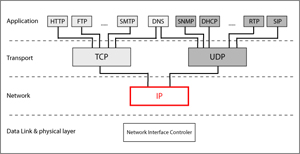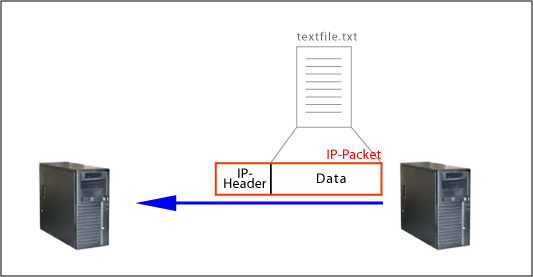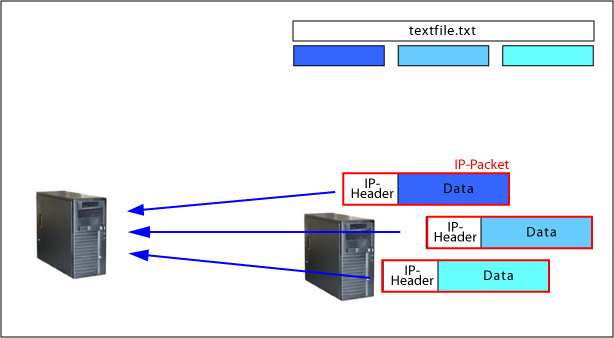1.1.3. Internet Protocol (IP)
|
At the heart of the Internet lies the Internet Protocol (IP). IP defines a packet switched network, where information is carried in packets (also known as datagrams) of bits between computers. The IP packet is the atomic transfer unit in the IP. It has a header containing information about the packet, and a data field (see picture below) where the content of the file that has to be transferred is stored. (GOSWAMI 2003, p. 10) |
 IP in the Protocol Hierarchy IP in the Protocol Hierarchy |
Considering our example the content of the textfile is stored in the data field and an IP-header has to be created. Afterwards, the textfile can be sent in form of an IP-packet to the other computer.
 Transferring the textfile using IP.
Transferring the textfile using IP.The IP packet has a maximum size which ranges from 0.5KB to 1.5KB or even higher (depending on the underlying network). Therefore if a filesize exceeds the maximum IP-Packetsize the file has to be splitted into several parts of the maximum IP-packet size. The next image shows this splitting.
 Splitting a textfile in several IP-Packets
Splitting a textfile in several IP-PacketsWhen a file has to be splitted into several IP-packets the packets are transferred independently.
 Transfer of the individual IP-Packets
Transfer of the individual IP-PacketsThe Internet Protocol is an unreliable best-effort service; i.e. it does not case guarantee about the IP-packets. The packet may arrive damaged, it may be out of order, it may be duplicated, it may be lost entirely, or not all of the packets may be arrived. If an application needs reliability, it is provided by other means, typically by upper level protocols such as e.g. the TCP. (WIKIPEDIA)
![]() The following animation part uses the term IP Address. If you do not know the
meaning of an IP address have a look at this popup window! (Click here for more information)
The following animation part uses the term IP Address. If you do not know the
meaning of an IP address have a look at this popup window! (Click here for more information)
The following figure shows the IP datagram. The IP datagram header is a
minimum of 20 ![]() bytes long and contains several
components.
bytes long and contains several
components.
Move mouse over the red text to get information about the function of the component.
IP datagramIn this lesson we discuss only the main components of the IP header. If
you are interested in detailed information of all components, have a look at
(GOSWAMI 2003, p. 11-16)
For all programs using the IP protocol, the source IP address and destination IP address are required in order to establish communications and send data.
